Before taking a walk along Fleet Street, a quick update on last week’s post.
Thanks for all the feedback via comments, e-mail and Twitter, which demonstrated that you cannot believe everything that you read in the papers, even back in 1915. Readers identified the following statues as earlier than that of Florence Nightingale, so my list of the first statues of women (not royalty) in London is now as follows:
- Sarah Siddons, unveiled at Paddington Green in 1897. Sarah was an actor, also known as the most “famous tragedienne of the 18th century”
- Boudicca, unveiled at the western end of Westminster Bridge in 1902. Some discussion about Boudicca as she could be classed as “royal” which the 1915 papers excluded, however I will keep her on the list
- Margaret MacDonald, unveiled at Lincoln’s Inn Fields in 1914. Margaret was a social reformer, feminist and member of organisations such as the National Union of Women’s Suffrage Societies
-
Florence Nightingale, unveiled at Waterloo Place in 1915
So that would put Florence Nightingale’s statue as the 4th public statue of a women unveiled in London (excluding royalty, or perhaps 3rd if Boudicca is classed as royalty).
Leave a comment if you know of any others.
The other point of discussion was the initials on the 1861 lamp post next to the Guards’ memorial. The combination of letters appeared to be SGFCG. Possibilities included the names of Guards Regiments, or a royal link with Saxe-Coburg Gotha (the Prince Consort as Colonel of the Guards was at the unveiling).
I e-mailed the Guards’ Museum and their feedback was that they had not seen the initials of the three Foot Guards Regiments combined in such a way elsewhere, however the initials do appear to fit the Regiments as they were known in 1861 – Grenadier, Coldstream and Scots Fusilier Guards.
Thanks again for all the feedback – there is always so much to learn about the city’s history.
On to todays post. Last summer I took my father’s old Leica camera out for walk. The first time this 70 year old camera had been used in 40 years. To test the camera I had purchased a pack of Ilford black and white film, and as there were some spare, I decided to take my old film camera out, a Canon AE-1 which was my main camera for around 25 years, but last used in 2003.
The Canon AE-1 was a significant camera when it came out in 1976. I purchased mine in 1977 from a discount shop in Houndsditch in the City on Hire Purchase, spreading the cost over a year. It replaced a cheap Russian made Zenit camera which had a randomly sticking shutter as a feature.
The Canon AE-1 was a revolution at the time. The first camera to include a microprocessor, it included a light meter and once the desired speed had been set on the ring on the top of the camera, the aperture (how much light is let in through the lens) would be set automatically. It was also possible to set both speed and aperture manually.
Focus was still manual, via a focusing ring on the front of the included 50mm lens.
My Canon AE-1:
The camera was powered by a battery in the compartment to the left of the lens in the above photo. Having not used the camera for almost twenty years, my main concern was that on opening the compartment, I would be met by a corroded mess, however the battery, although flat, was in good condition, and after replacing with a new battery, the camera came back to life.
Inserting a new film was much easier than the Leica as the film did not need to be trimmed, simply pushing the end of the film into the take up spool and winding on until the rewind knob moved.
I took the camera for a walk along Fleet Street, hence the title of the post – Fleet Street in 32 Exposures. I was using a 36 exposure film, so lost some in initial testing to make sure the film was winding on correctly.
Fleet Street seemed a good choice, as the street is lined with fascinating buildings. Substantial buildings from when newspapers occupied much of the street, to tall, thin buildings which are evidence of the narrow plots of land that were once typical along this important street. Many of the buildings are also ornately decorated.
This will be a photographic look at the buildings rather than a historical walk. Fleet Street has so much history that it would take a few posts to cover.
So to start a black and white walk along Fleet Street. I started at the point where the Strand becomes Fleet Street and the Temple Bar memorial:
The Temple Bar memorial dates from 1880 and was designed by Sir Horace Jones. It marks the location of Wren’s Temple Bar which marked the ceremonial entrance to the City of London. The original Temple Bar now stands at the entrance to Paternoster Square from St Paul’s Churchyard.
Statues of Queen Victoria and the Prince of Wales are on either side of the monument, which is also heavily decorated and shows the Victorian fascination with the arts and sciences, with representations of these lining either side of the alcoves with the statues.
The Grade I listed Middle Temple Gatehouse which leads from Fleet Street into Middle Temple Lane. The building originally dates from 1684:
The Grade II* listed Inner Temple Gatehouse between Fleet Street and the Inner Temple location of Temple Church:
Cliffords Inn Passage and the entrance gate to Cliffords Inn:
The church of St Dunstan in the West:
The head office building of the private bank of C. Hoare & Co. Founded by Richard Hoare in 1672, the bank has been based here in Fleet Street since 1690:
Offices of publishing company DC Thomson, who still publish the Sunday Post and People’s Friend as well as the Beano. This is their London office, with their head offices being in Dundee (hence the Dundee Courier):
Mitre House, with the entrance to Mitre Court:
The original home of the London News Agency, also known as the Fleet Street News Agency. The business was here in Fleet Street from 1893 until 1972 when the business moved to Clerkenwell, where it was based until the agency closed in 1996.
The entrance to 49 and 50 Fleet Street, a Grade II listed building that dates from 1911. Originally Barristers’ Chambers, in 2018 the building was converted into an extension to the Apex Temple Court Hotel.
The following photo is of 53 Fleet Street and is a good example of where black and white is the wrong film to capture the features of a building. The upper floors are decorated with dark red bricks with green bricks forming diamond patterns, which can just be seen in the photo. It looks much better in colour.
The following building is the Grade II listed former office of the Glasgow Herald built in 1927. The building is relatively thin and tall and the challenges with photographing the building using a fixed 50mm lens are apparent as I could not get in the top of the building without the front being at too oblique an angle.
The 1920’s Bouverie House, with entrance to St Dunstans Court at lower left:
Almost opposite Bouverie House, Whitefriars Street leads off from Fleet Street. A plaque on the wall records that this was the location of the office of the Anti-Corn-Law League between 1844 and 1846.
A wider view of the building on the corner of Whitefriars Street and Fleet Street. The above plaque can be seen on the wall to the left of the corner entrance. The pub just to the right of the corner building is the Tipperary at 66 Fleet Street.
The following photo shows a view along the northern side of Fleet Street and highlights the mix of different building ages, materials and architectural styles that make this street so interesting. One of the oldest building on the street is in the centre of the view. The Cheshire Cheese pub dates from 1538 with the current building dating to 1667.
Next to the Cheshire Cheese is this rather ornate building which is currently home to a Pret on the ground floor. This is the Grade II listed, 143 and 144 Fleet Street. The statue in the centre of the first floor is of Mary, Queen of Scots.
The building in the above photo was constructed in 1905 for Sir John Tollemache Sinclair, a Scottish MP, and designed by the architect R.M. Roe. Whilst researching for the reason why the statue is on the building (Sinclair was a fan of Mary Queen of Scots), I found the following newspaper report from The Sphere on the 17th August 1946 which provides a description of the use of the building:
“Although at first glance, this life-size statue of Mary, Queen of Scots appears to be in an ecclesiastical setting, it is, in fact, situated above a chemist’s shop and a restaurant in one of the older and grimier buildings of Fleet Street. No. 143-144 Fleet Street, known as Mary, Queen of Scots House, contains a typical selection of Fleet Street tenants – newspaper offices, advertising agents and artists agents”
Next to the above building is a lost pub, the building in the following photo was once the Kings and Keys pub.
The name of the pub can still be seen carved in the decoration between the first and second floors.
The Kings and Keys closed in 2007, and in the days when Fleet Street newspapers had their local pub, this was the pub for the Daily Telegraph. Although the building dates from the late 19th century, a pub with the name Kings and Keys had long been on the site. A newspaper report from 1804 highlights the dangers for those travelling through London and stopping at a pub:
“Last week a young midshipman, from Dover, going to Oxford on a visit to his relations, stopped at the King and Keys, in Fleet-street, for refreshment, when a fellow-traveler, whom he had supported on the road, attempted to rob him of his box, containing his money and clothes, which was prevented by the waiter; the ungrateful villain unfortunately made his escape”.
Across the road is a closed and boarded Sainsbury’s Local. One of the casualties of the lack of people travelling to work in Fleet Street during the lock-downs.
On the front of the above building is a plaque recording that it was the site of Bradbury and Evans, Printer and Publisher of Dickens and Thackeray between 1847 and 1900.
And to the left of the building is a memorial to T.P. O’Connor, Journalist and Parliamentarian 1848 to 1929 – “His pen could lay bare the bones of a book or the soul of a statesman in a few vivid lines”.
Next to the old Kings and Keys building is the old offices of the Daily Telegraph newspaper. Built for the newspaper in 1928 and now Grade II listed.
The building is a good example of the power and authority that the newspapers wanted to project when they were still the main source of news, before radio and television had become a mass market source of news.
Next to the Telegraph building is Mersey House, built between 1904 and 1906:
Mersey House is yet another Grade II listed building, and was the London home of the Liverpool Daily Post (which is probably the source of the Mersey name after the River Mersey). The newspaper cannot have been using all the space in the building as in 1941 they were advertising:
“Do you want a London Office with a Central and Appropriate Address? Accommodation can be had in Mersey House, Fleet Street, E.C. 4 – Apply the Daily Post and Echo, Victoria Street, Liverpool”.
There are substantial stone clad buildings on many of the corners of Fleet Street. This is 130 Fleet Street on the corner with Shoe Lane:
And a typical bank building on the corner with Salisbury Court. The plaque to the right of the door records that “The Fleet Conduit Stood In This Street Providing Free Water 1388 to 1666”.
The majority of buildings that line Fleet Street are of stone, however there is one spectacular building of a very different design and using very different materials. The following photo shows the lower floors of the Grade II* listed Daily Express building dating from 1932.
The above photo shows the limitations of using a fixed lens. impossible to get the whole building in a single photo. These are the upper floors:
The art deco building was designed by architects H. O. Ellis & Clarke with engineer Sir Owen Williams. The materials used for the building could not be more different than the rest of Fleet Street.
Vitrolite (pigmented, structural glass) along with glass and chromium strips formed the façade of the building, to give the building a very modern, clean and functional appearance at the start of the 1930s.
Four years after completion, the building was used as an example in an article on “Architecture – the way we are going” in Reynolds’s Newspaper to demonstrate the battle of architectural ideas, and the type of design and materials that will be the future of office and industrial buildings
The building can really be appreciated when seen as a complete building, and the following postcard issued as construction was finishing, shows the building in all its glory:
On the opposite side of the street is the old building of the Reuters news agency, one of the last of the news agencies to leave Fleet Street in 2005. The following photo shows the main entrance to the building and according to Pevsner is recognisable as the work of the architect Sir Edward Lutyens by “the wide, deep entrance niche on the narrower Fleet Street front”. Above the door, in the round window is the bronze figure of Fame.
View looking down Fleet Street, with the dome of St Paul’s Cathedral in the distance:
The following photo is looking back up Fleet Street. in the centre of the road is one of the old police sentry boxes introduced during the early 1990s in response to the IRA bombing campaign in the City of London.
I have now come to Ludgate Circus, where Fleet Street meets Farringdon Street, and where the old river that gave the street its name once ran.
The clock on Ludgate House:
That is Fleet Street in 32 exposures, and it proved that my 44 year old camera is still working.
The Canon AE-1 was a joy to use. Taking photographs with a film camera does feel very satisfying. After each photo, the act of pulling the lever to wind the film feels like you have done something a bit more substantial than just the shutter click of a digital camera.
There is a story that Apple used the sound of the shutter on the Canon AE-1 as the sound when taking a photo on an iPhone – it does sound very similar, but I am not convinced.
Black and White photography is good for certain types of photo. It does bring out the texture in building materials, but I still have much to learn to use this type of film for the right type of photo (when using the Canon I mainly used colour film).
The fixed 50mm lens was also a problem with trying to photograph larger buildings in a confined space. In my early years of using the camera I could not afford any additional Canon lens, but did buy compatible Vivitar 28mm and 135mm lens which I need to find.
Fleet Street has such a rich collection of architectural styles, and the legacy that the newspapers have left on the street is still very clear. It is a fascinating street to walk.

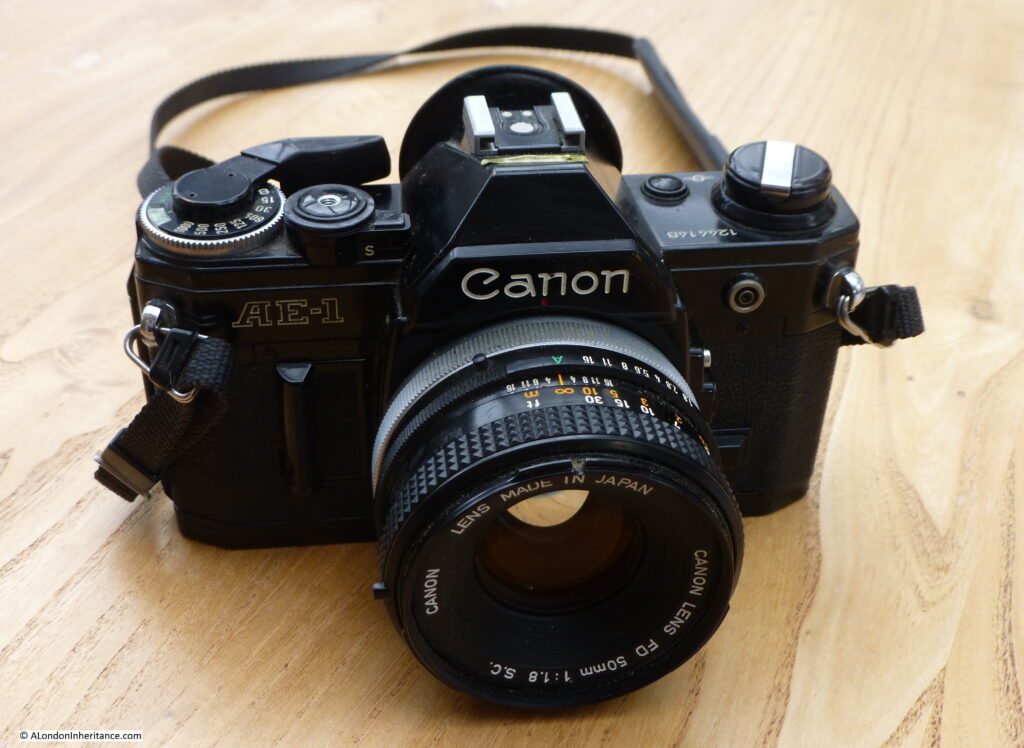

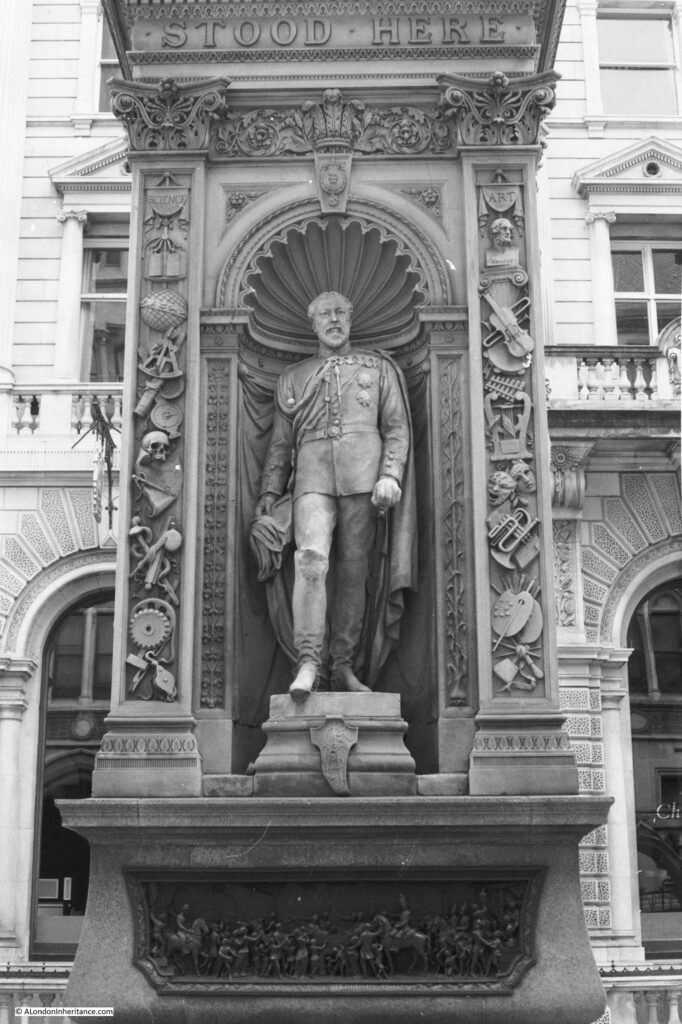

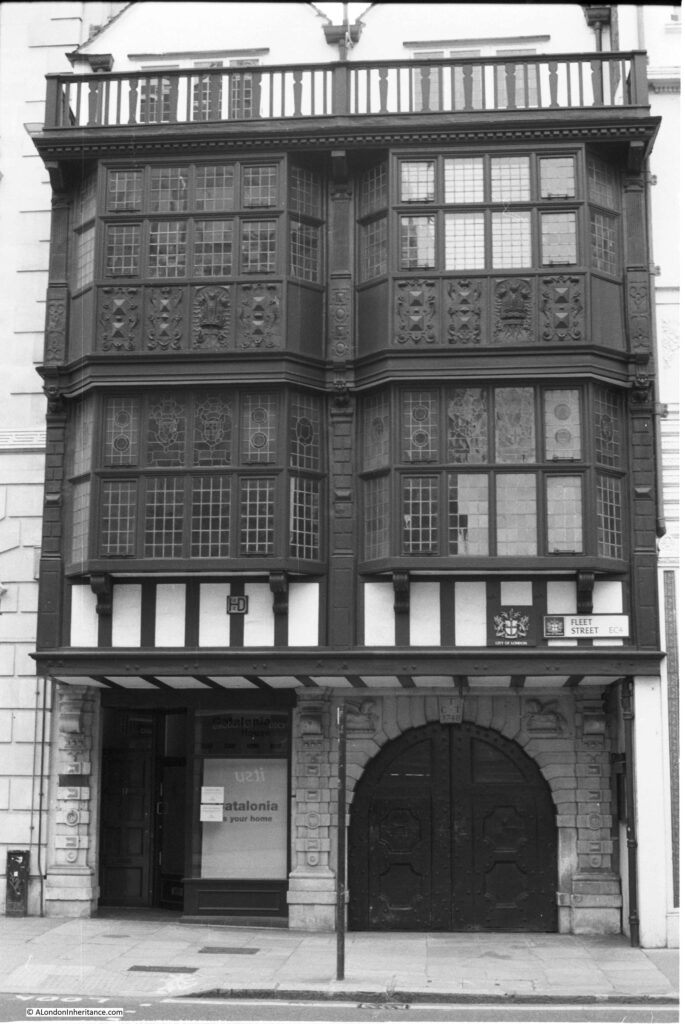
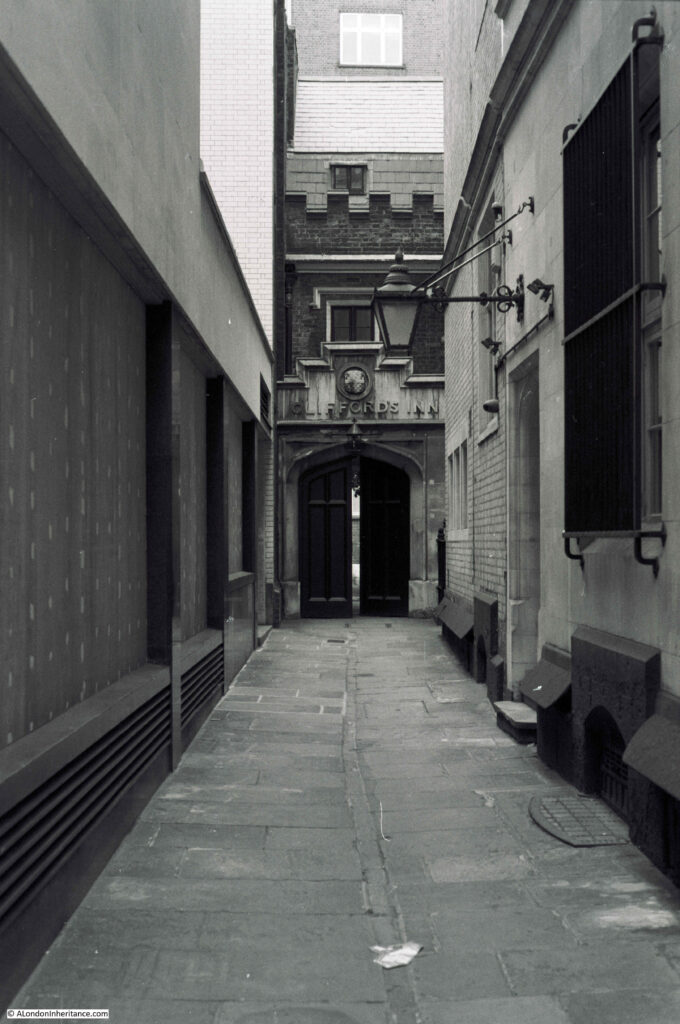

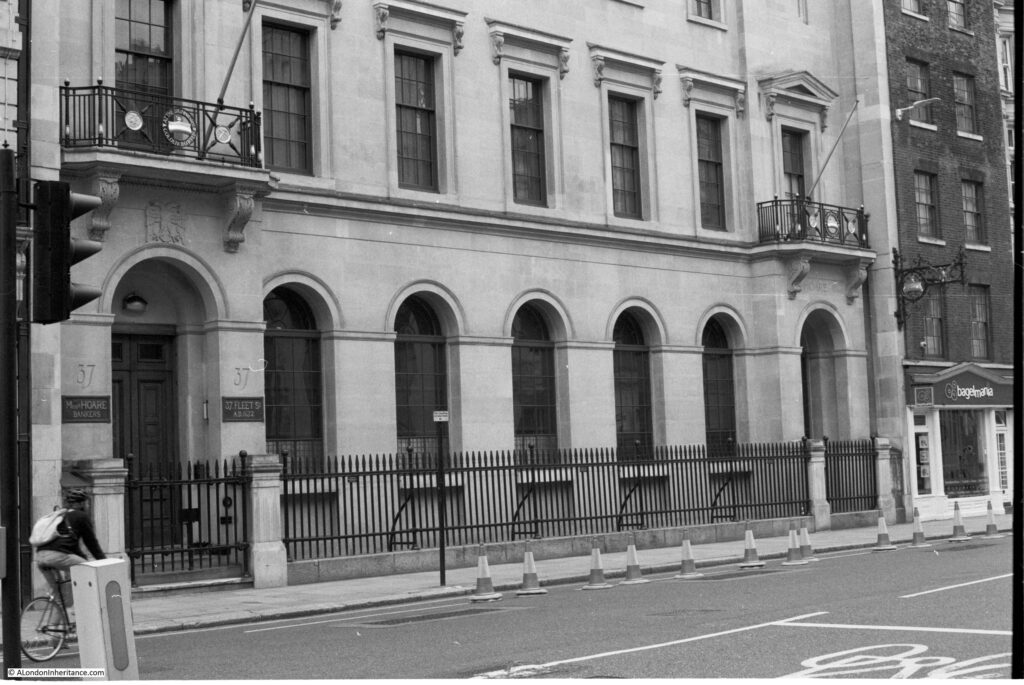
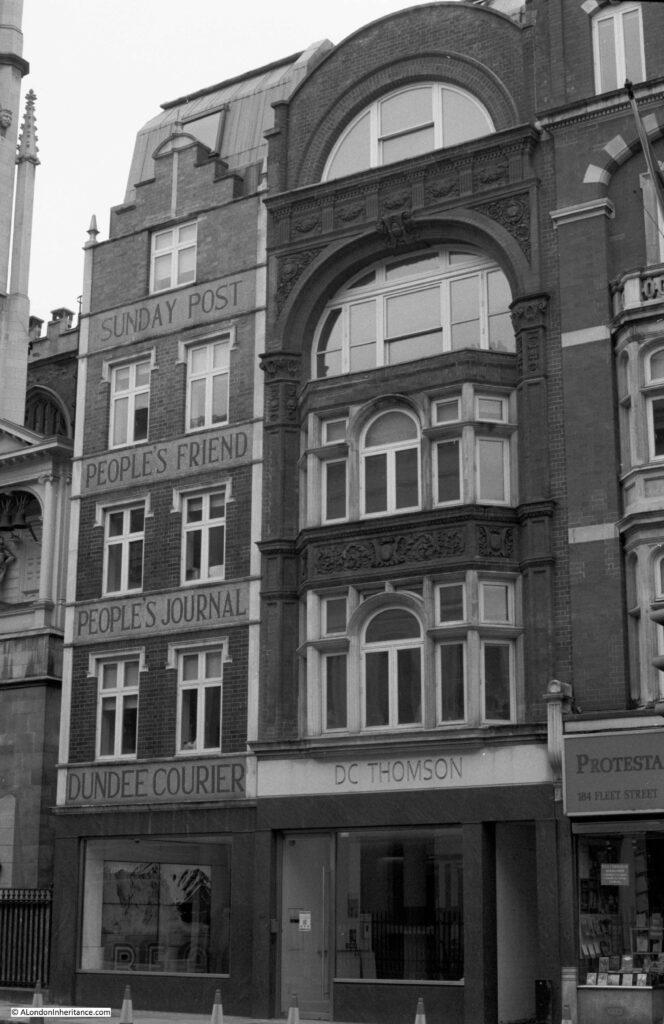


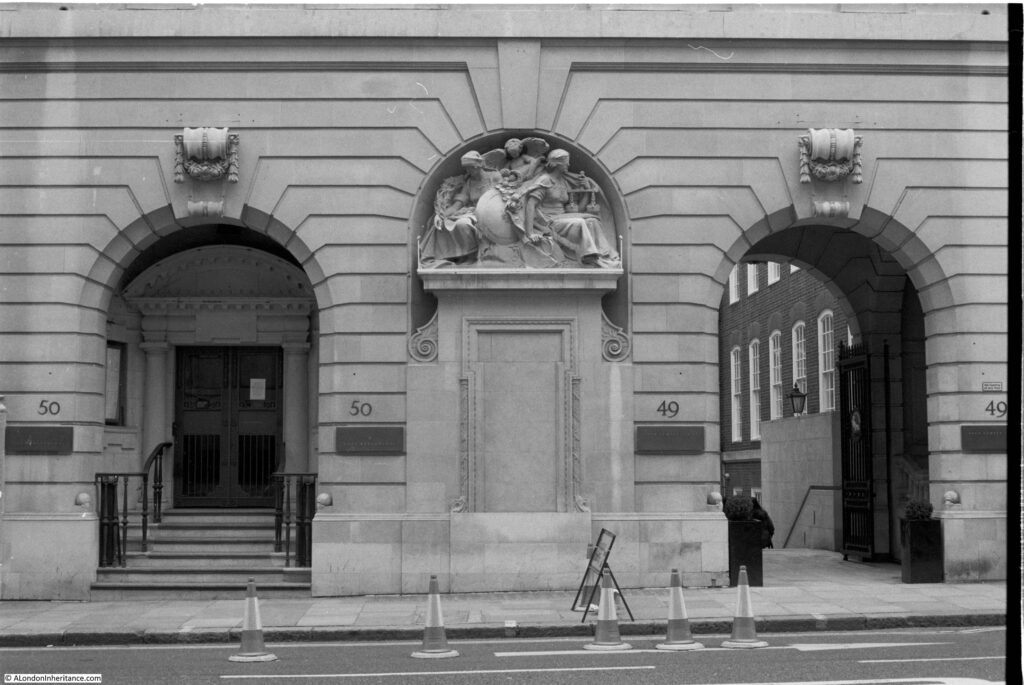
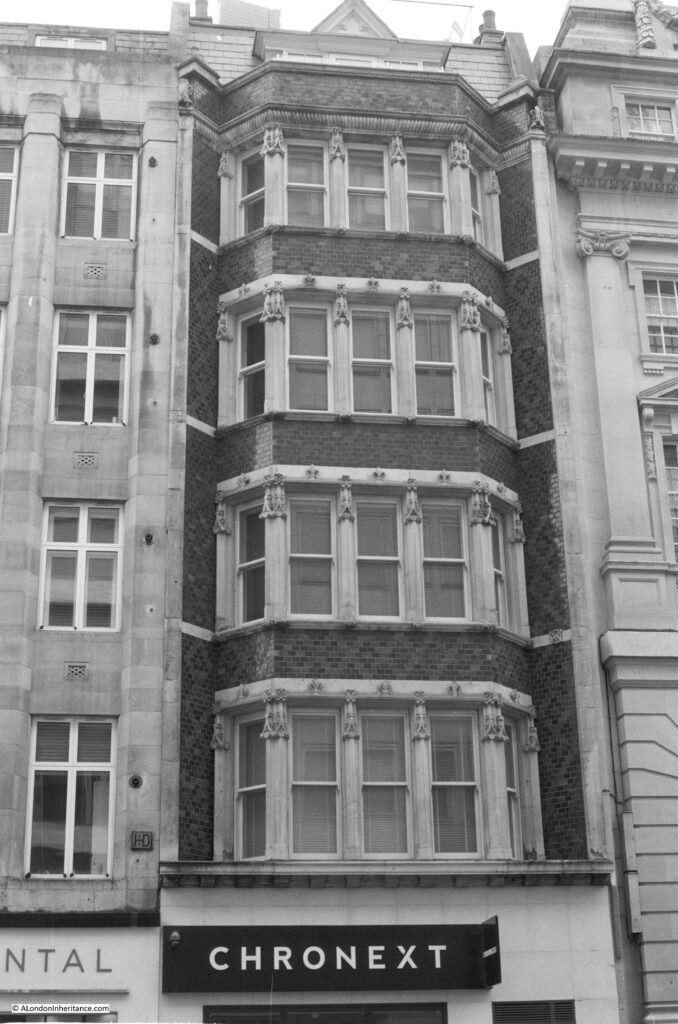
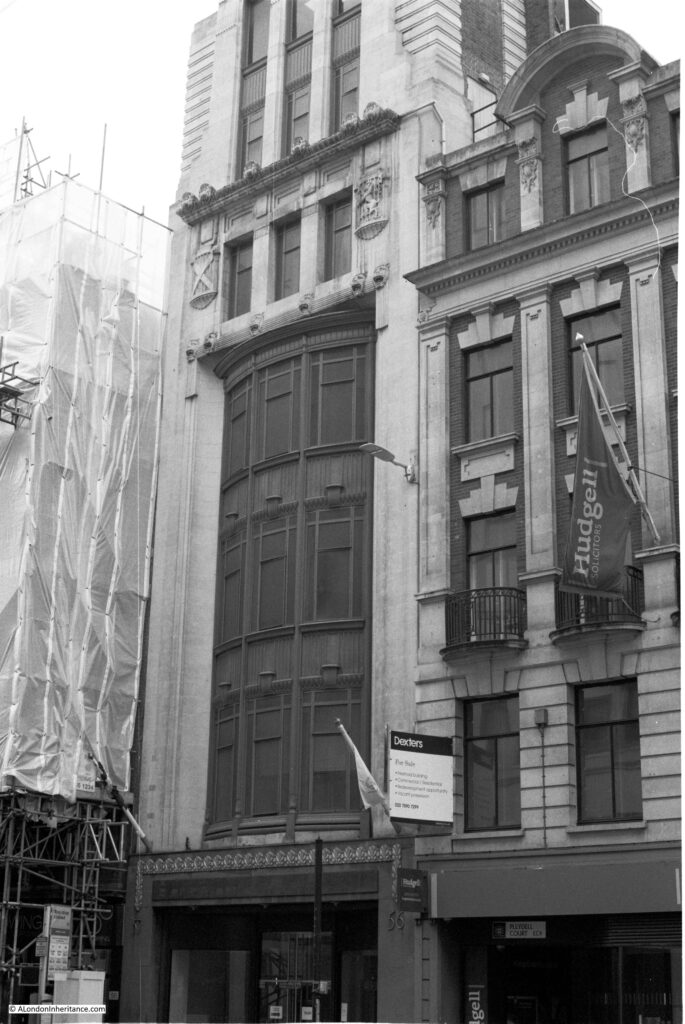

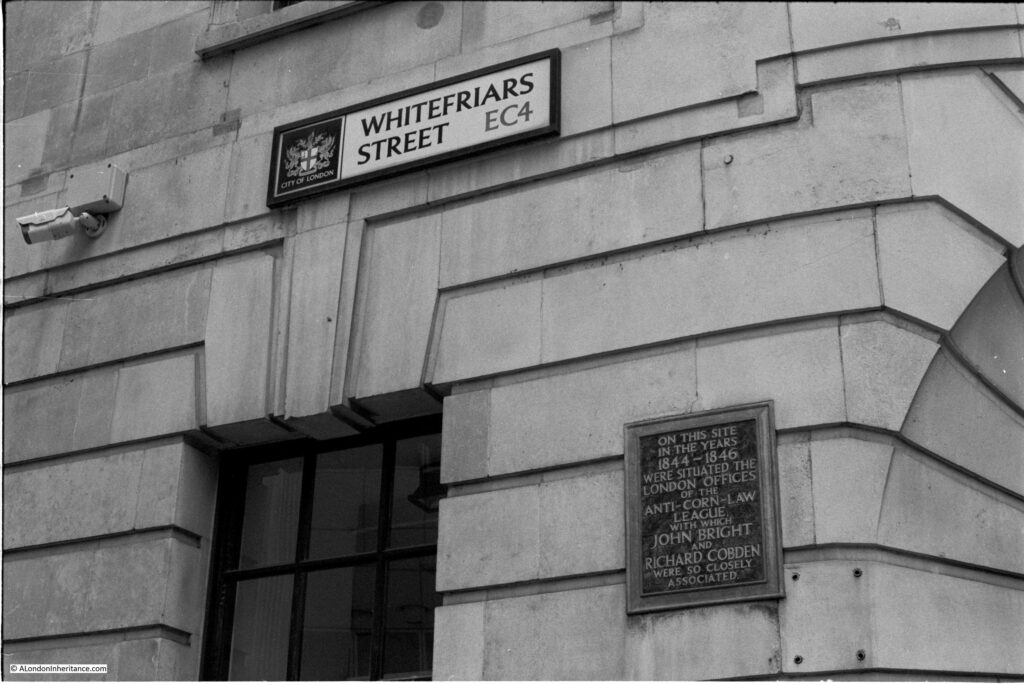
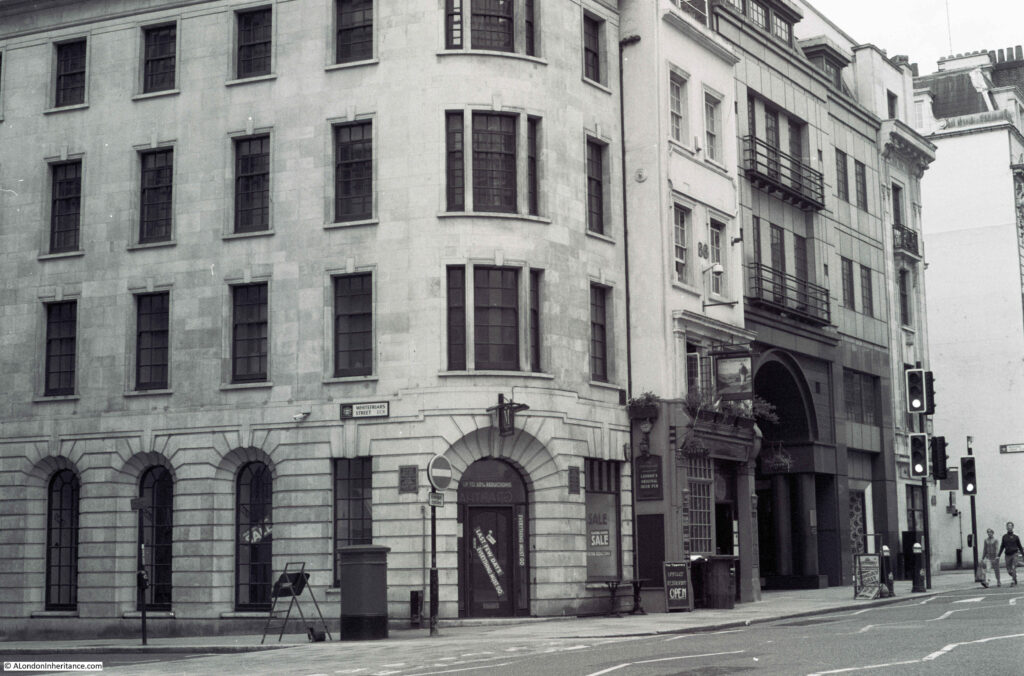
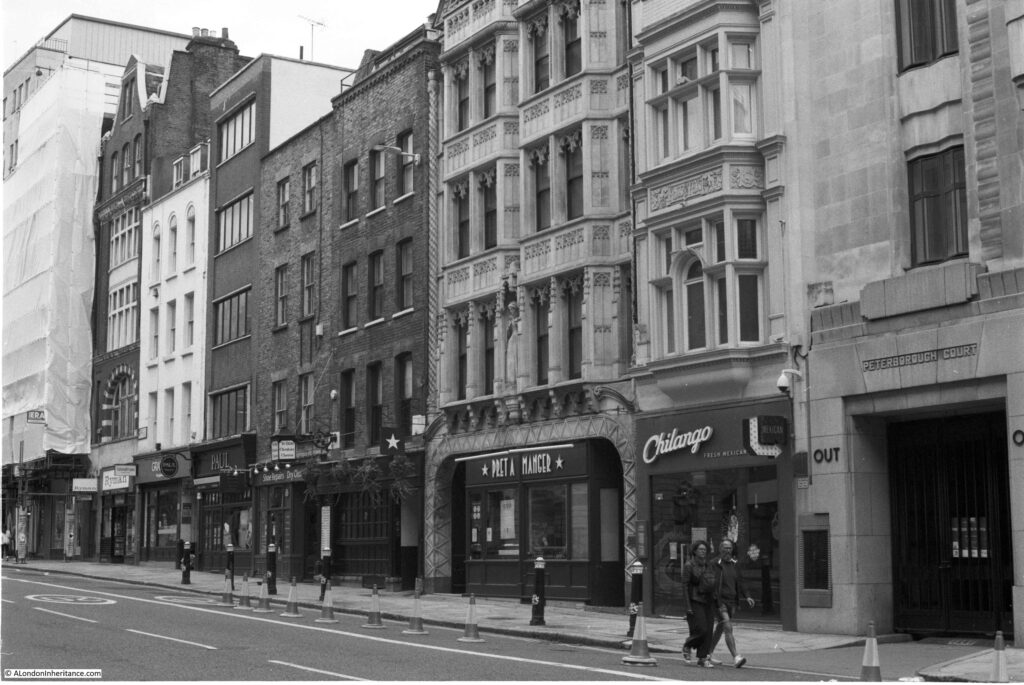
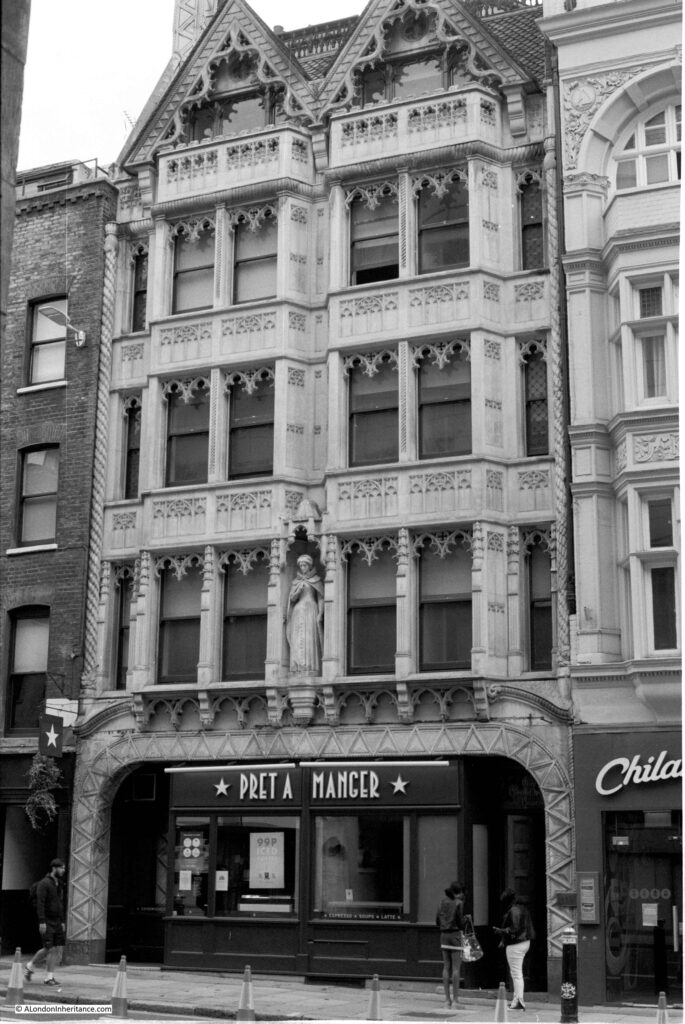
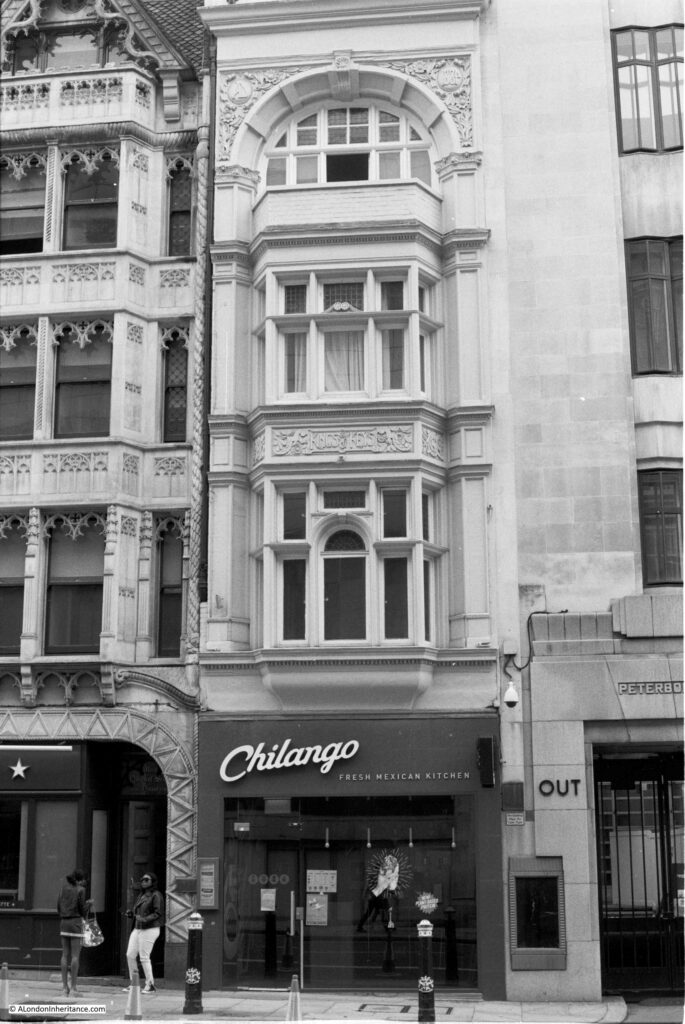
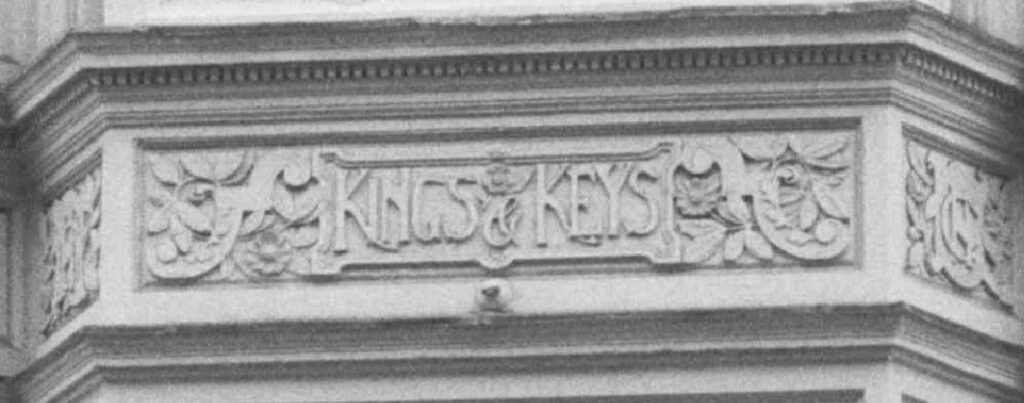
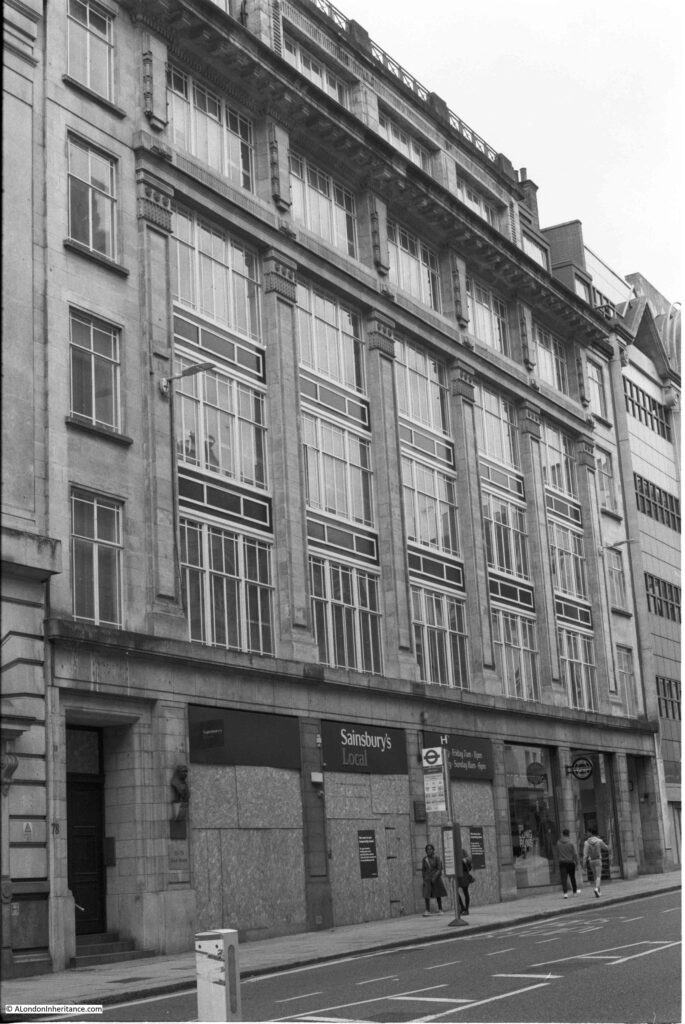
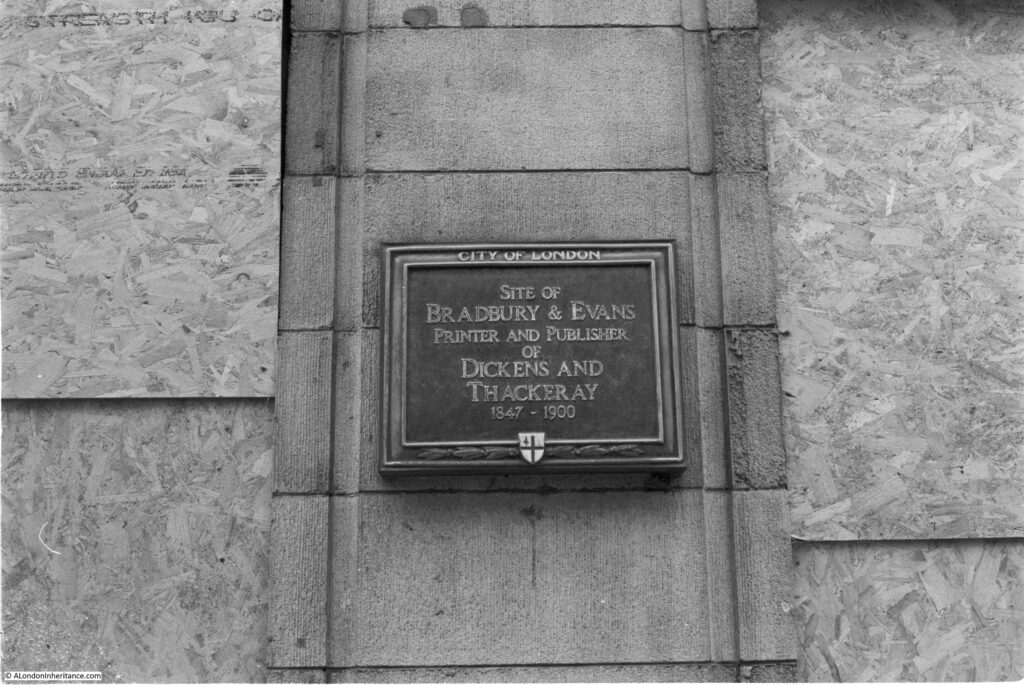

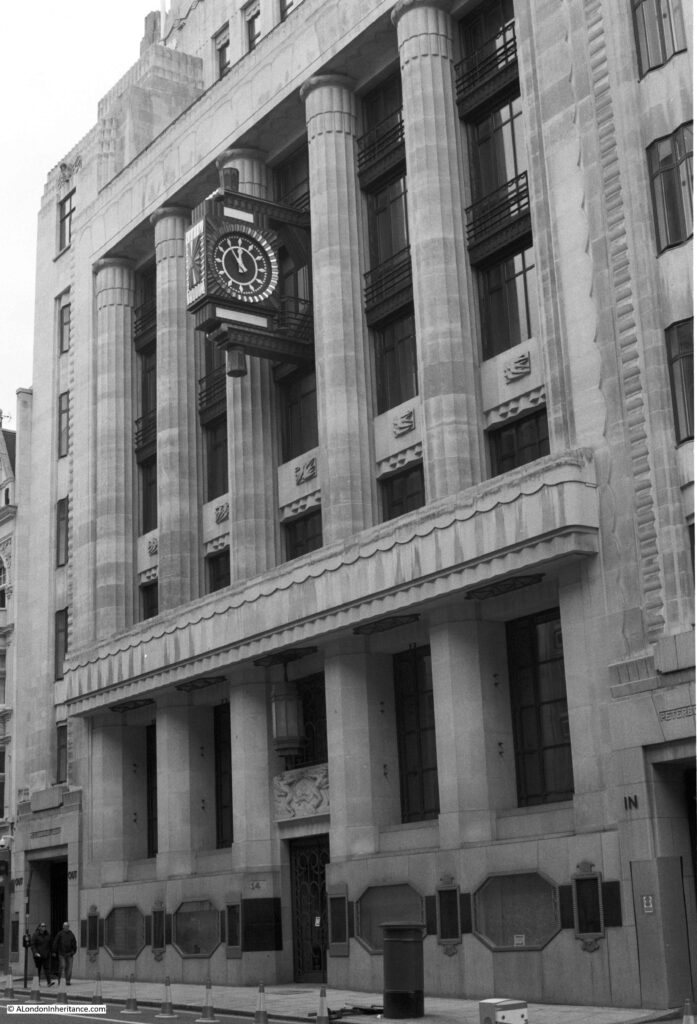
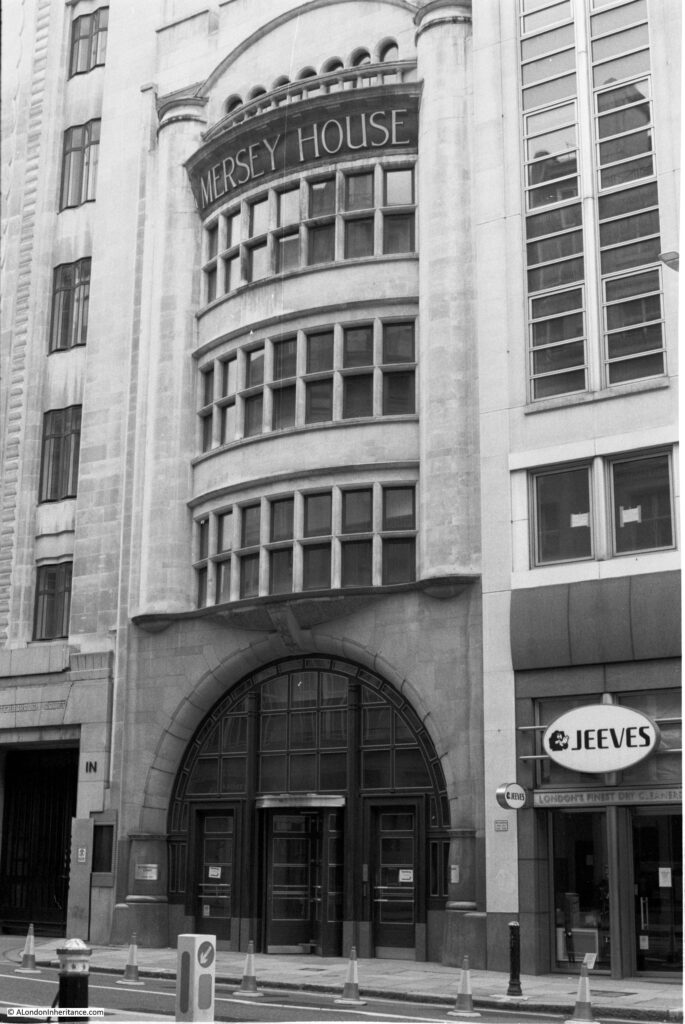
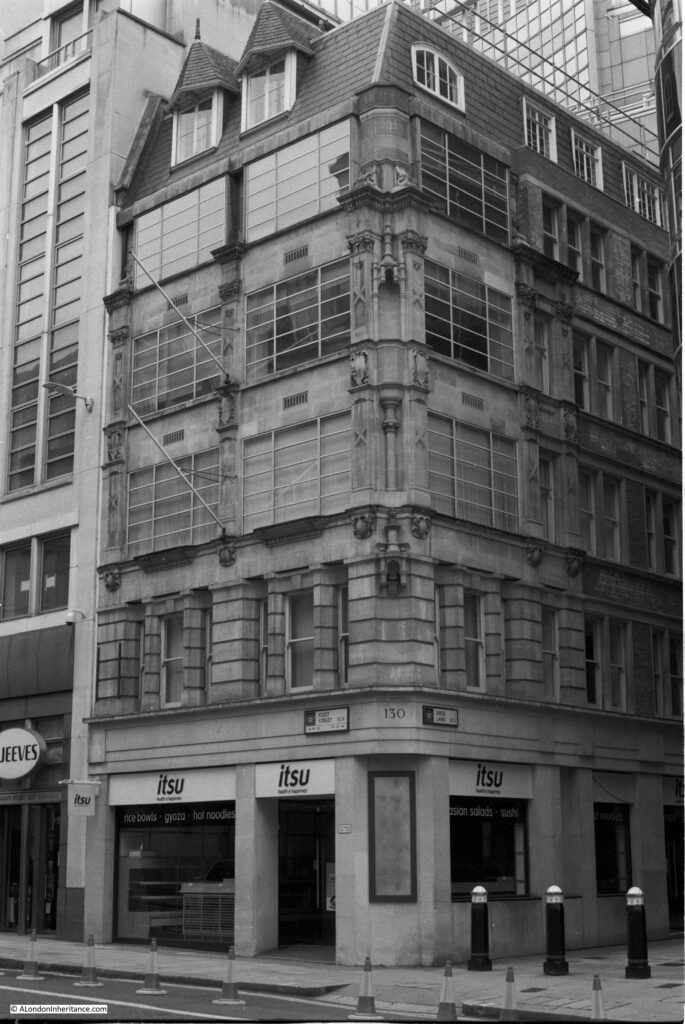
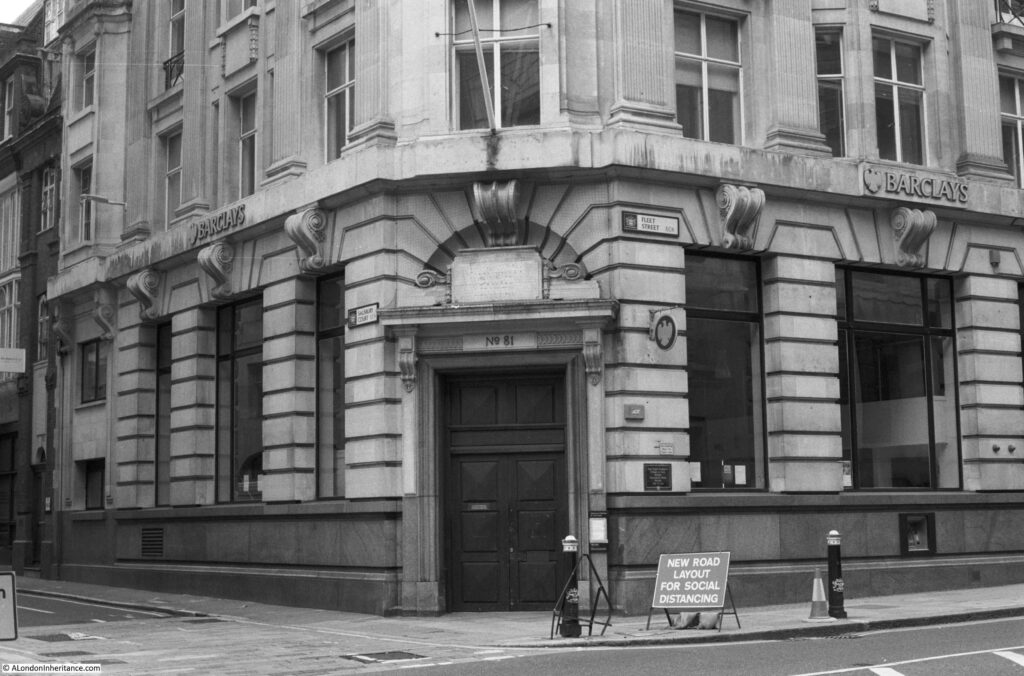
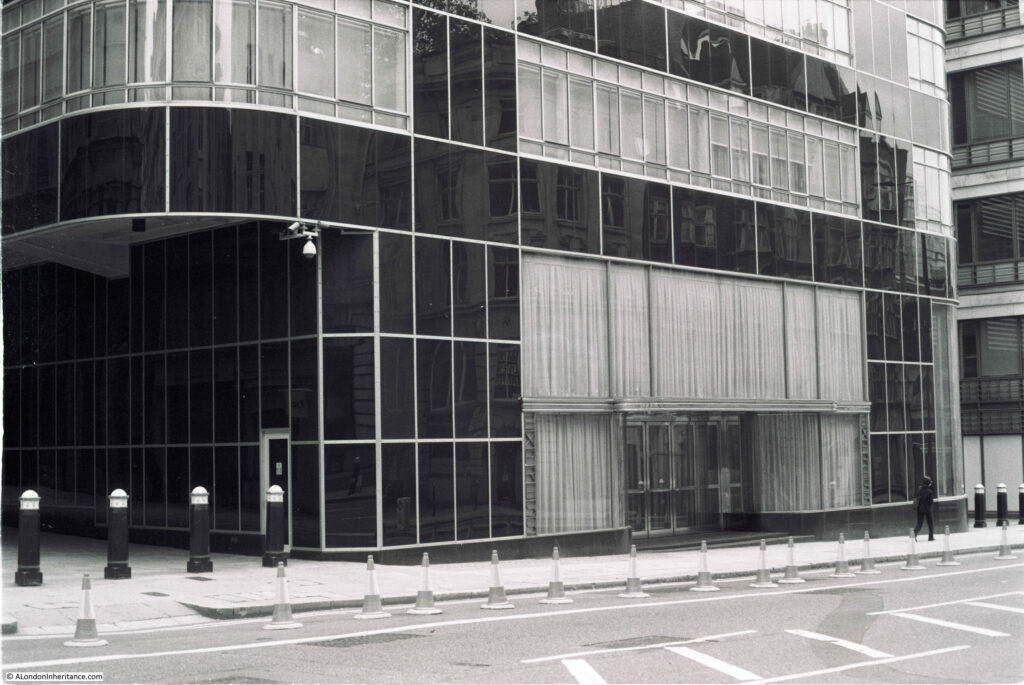


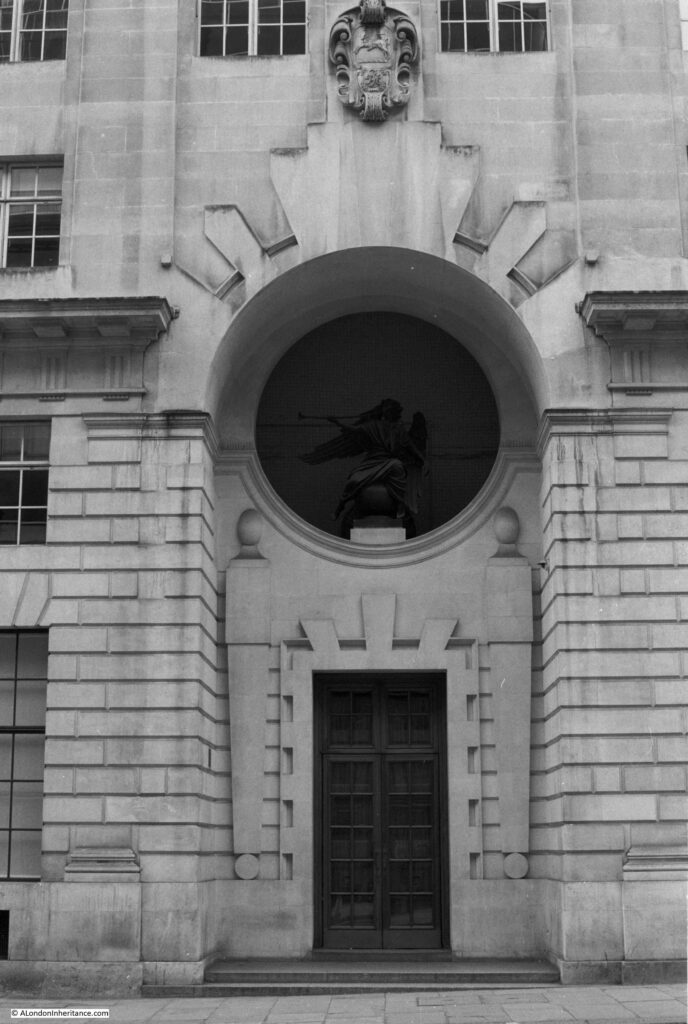



Thank you for this ‘walk’ along Fleet Street. Your clear photos have individualised the many buildings which, if passing by on foot, could become a blur.
Thankyou for this wonderful trip down memory lane. I used to get the bus down from City Thameslink to Charing Cross to get to work.
I can remember starting work as a copy boy in the daily Express in Dec 1951 , After a while I became a Beaverbrook boy , Who worked the teleprinter an small phone exchange for Lord Beaverbrook , When he was in the UK ,
I added your page to the French Wikipedia page on Fleet Street : https://fr.wikipedia.org/wiki/Fleet_Street#Lien_externe.
Thank you for your work, which I always discover with pleasure.
I also had a Zenit as my first SLR and was looking for an improvement when the AE-1 appeared and I was hooked by its many modern features. I was able to buy some Canon lenses as well and in ’78 I used it extensively on a trip around N America with my wife. Eventually however i was also infatuated with digital photography and sold it. I must admit a compact digital camera still is my main camera but some years back a friend who was sadly leaving us and with whom I had talked photography for years gave me his camera and lenses and it was another AE-1. I still have it and it works well. I also used it for monochrome photos whereas back in ’78 it was , of course, Kodachrome which as someone said gave us the nice bright colours!
I love your trip around Fleet Street which reminds me of my many trips there to the RCJ and Somerset House as an articled clerk to a solicitor in the 1960s.
The City of London plaque to Bradbury & Evans is completely inaccurate. The City of London know about this (I told them) but they were apparently not concerned about the inaccuracy. The printers and publishers Bradbury & Evans were never at that site on Fleet St. They were round the corner in Bouverie Street – always. And somehow the plaque fails to mention that B&E were publishers of Punch magazine! Bouverie St itself is well worth a visit – it was a fascinating microcosm of ‘Fleet Street’ with News of the World (formerly) sitting opposite Punch/Bradbury & Agnew (the successors to B&E) as well as many other publishers, news agencies, etc. The News of the World building has gone, but the Bradbury & Agnew/Punch building is still there (at least its exterior is). It is now the Polish consulate/Polish Cultural Institute. The arched window at the top of the building was once a niche that held a larger than life-size statue of Mr Punch that is now in the British Library.
Brings back memories I used to work In a press photographers on Ludgate hill in 1961, I brought my first reel to reel tape recorder in a shop in fleet st ,called Sterns.and I used to have my lunch in the Soup kitchen that was in Shoe Lane ,very fond memories of those times.
A double bonus today – a classic film camera and a trip down Fleet St, where I worked as a messenger boy for Longacre Colour Labs, film processors for the IPC Group magazines. They were in Red Lion Court, near Dr Johnson’s house. As I was only 17, I took scant notice of the buildings as I delivered artwork to various advertising agencies around the capital. Last visit to London, I took a bus from the Savoy to South Kensington, via Fleet St. Shoe Lane always stands out for me as the scene of a collapsing wall which killed two volunteer AFS firemen during the Blitz. Can’t wait to revisit the area.
Some excellent photos showing the wide variety of building styles that make up Fleet Street. Thanks again for all the work that you put into these posts.
Re: Sarah Siddons,
Here in Royal Leamington Spa are two buildings of note amongst the many that make up the town. One was originally the first Library in the town, the other one of the early theatres. The theatre was built in 1813 but changed use in 1831 to become The Chair and Rocket public house. Now both buildings have amalgamated to become The Old Library.
Sarah Siddon appeared at the theatre on a number of occasions to rave reviews and such was her “fame” and connection to the area a new public house named after the famous actress was opened on a new housing estate in Warwick in 1978.
Sadly, for some reason, the owners decided some years ago to rename the pub the “Woodloes Tavern” not that it looks anything like a tavern!
Brillant post, inspires me to walk there myself instead of seeing it through the bus window.
Its nice that a considerable number of buildings along Fleet Street are listed structures, there are many different styles and ages but as a whole they present an interesting and pleasurable look to the street.
Thank you for showing us some in detail.
This has brought back some memories. I worked in the City from 1979-1984 and walking up Fleet Street used to be a regular lunchtime walk. I remember seeing great big rolls of paper being delivered to the News of the World in Bouverie Street. Sad to think that not only are none of the newspaper offices there anymore but that the News of the World doesn’t exist anymore. At one time it had a good reputation and not the sleazy rag that it turned into.
I love how black and white photography can bestow a certain timelessness on its subjects – that picture of Cliffords Inn Passage in particular feels like it could have been taken at any time in the last 100 years or more.
Thanks for these photos of one of my favourite bits of London. Black and white photographs lend a nostalgic but somehow timeless quality. I’d find it difficult to immediately date them! Also I’ve discovered that traditional non-digital photos aren’t exactly black and white but often have a ‘colour’ to them.
In the 1950s, my father was a van driver working for WHSmith and the Evening News, so was around here every day. School holidays offered a chance to go to work with him, so I got to know Fleet Street and its side streets quite well, and can pinpoint the sites places that are no longer to be seen. When I left school and trained as a compositor, the ambition of my fellow apprentices was to get a job on Fleet Street where the pay was highest, but for some reason (probably the odd hours) I was never interested.
In retirement a City guide, I love to lead tours around this area in an attempt to recall the lost noise and bustle of what was a 24 hour street.
Fascinating walk, and a nice trip out for your old camera. Edwin Lutyens designed much of New Delhi’s government buildings in the time of British rule. His assistant, Herbert Baker, designed many of the houses for the (British) civil servants there. Not very well; they proved cold in winter and fearsomely hot in summer. They acquired the name “Bakers Ovens”.
Thank you for such a lovely tour of Fleet Street-I left London in the sixties.
The other well-known business that is owned by D C Thomson is Findmypast :-
https://www.dcthomson.co.uk/companies/findmypast-2/
That is quite a contrast to the very traditional the “People’s Friend”.
Great post and fantastic photos. I worked on Fleet Street for most of the 2000s and it brought back lots of memories, as did the reference to a Zenit, which was my first SLR. I can also recommend exploring some of the alleys on either side of Fleet Street, especially those behind the Cheshire Cheese which lead to Dr. Johnson’s House. There is also the wonderfully named Hanging Sword Alley near the top of Whitefriars but I think that only led into a courtyard within a 70’s office block.
I love the old Daily Express building, a real beauty of streamline moderne style (or something like that).
In 2014, I took a walk from my rental flat in Spitalfields down to the Temple Church entrance on Fleet street and took many pictures. Your set and mine overlap. Here are my photos, all in color, taken with my then-new Canon dSLR: https://www.flickr.com/photos/irontongue/sets/72157645194063154/with/14430932565/
Question about the Daily Telegraph building: the carvings on it apparently indicate that it’s called Peterborough Court, and I was wondering if you know how that name overlaps with the Daily Telegraph.
Found another lovely blog on here that gives the answer:
https://memoirsofametrogirl.com/2019/02/26/peterborough-court-fleet-street-daily-telegraph-history-architecture/
I remember the “Peterborough” column – my father used to take the Telegraph, and my son and I both cut our crossword-solving teeth on it.
Thank you so much, Karen!
You’re welcome – I was delighted to find it!
Enjoyable read. The AE-1 was my brothers first good camera in the day and still fondly recollected. So glad you loaded with B&W for this trip. As you say some features require colour although by and large B&W works well in capturing Fleet Street.
Thank you for this great review. I worked in ad agencies from 1964 and part of my junior! job was to run copy and blocks down to Fleet Street advertising departments. All the great newspapers and Sundays as well, there was nothing more exciting for a provincial lad than Fleet Street at night when the underground rotary Goss letterpresses started up. The whole street vibrated . WE had a few visits to see the press room, strictly under control of the Father of the Chapel and seriously unionised, hence their move to Docklands inspired by the great Eddie Shah. The Wig and Pen Club was a great haunt as was El vinos.
Super days with 1960s London rocking as well
There’s a statue to Mary Seacole, St Thomas Hospital grounds. Unveiled 2016.
Thank you for your splendid expeditions with the Leica and Canon. The black and white shots of Fleet Street are most interesting and evocative.
It’s good to keep in touch with film camera technology and the importance of shutter speed, aperture, depth of field and ASA film speed.
Often when using my various digital cameras it seems so easy to leave the setting on ‘Auto’.
I’ve always tried to keep my ‘old’ cameras as they’ve served me well and are like old friends. Now and then I get one out and put a film through.
Yes, my 1935 Leica is fiddly with so many things to remember. The Yashicaflex, Zena Bronica, Olympus OM1 (and several Minox for fun) are such beautiful instruments but I just need time to remember what to do first.
However, when it comes to cost of film, processing and printing then the sheer convenience of the digital age shows it’s true worth!
Thank you for another superb post.
I worked on the Aldwych and used to walk down Fleet Street at lunchtime. Apart from St Brides my favourite sight was the Daily Mail car park, festooned with supercars. Man Utd eat your heart out.
Once again a fascinating series of photos. Your posts are a continuing pleasure to receive.
Around the same time as you did,I also upgraded from a Praktica camera to a Canon A1, bought it on HP at the Houndsditch as well.The name of the Camera shop It was McKinnons, it was a popular discount retailer at the time.
Look forward to coming down to London and walking fleet st amongst others
The Canon AE-1 is still a significant camera. Its distinctive shutter sound is the one used by Apple for iPhones!
https://fstoppers.com/audio/apples-camera-shutter-sound-was-recorded-canon-ae-1-235816
Thanks for the link Roger. Good to have confirmation that it was an AE-1
Apologies for not reading right to the very end when I posted my comment! At least the link does add some more background to the Apple connection.
Interesting article (as always) and nice photographs. I had an AE-1 but changed to an AV-1, less for me to think about!
If you want more info about London News Agency (or other Fleet Street bids) go to photo archive news and look at press photo history section. Stories from old chaps who worked as snappers. Another world of black and white, letterpress etc. I was always nostalgic as everyone was long gone from the street of shame by the time I first worked for newspapers but I loved hearing the tales, tall and otherwise. Loved looking at all those old frontages, b&w seems appropriate. ttfn.
Thank you for such an interesting tour of Fleet Street and the printing industry. I too had a Zenit as my first ‘grown-up’ camera. purchased from the photographic shop in Holbein. The biggest problem was that given the internal mirror moved aside to take the photo, the clunking sound made any sense of discreet photography virtually impossible. Lots of photos of startled faces. My next camera was an OM1 – beautiful and much later to a Cannon digital.
That branch of Barclays (81 Fleet St.) was where I opened my bank account in 1984. I had just stared working in The City, for an advertising agency in Farringdon Street. I took a cheque for £200 advance salary and a letter from the boss’ secretary – that’s all that was needed. Happy days.